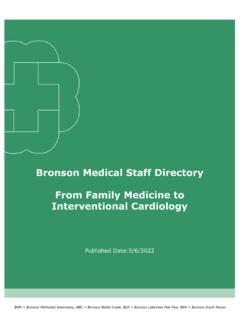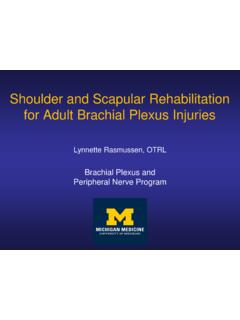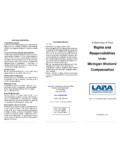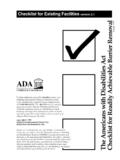Transcription of Bronson Cardiac Rehabilitation Home Exercise Program ...
1 - 1 - Bronson Cardiac Rehabilitation Home Exercise Program Guidelines - 2 - Table of Contents Words to Exercise Is Exercising At Home .. 5 Warming up and 5 Aerobic 8 Resistance The Other Weight 24 Activity 28 30 31 Introduction This book has been designed to help you with your home Exercise activities. Definitions of words often used are included as well as an explanation of the parts of an Exercise Program , and the importance of each part. This book will give you specific information to follow so that you may follow your Exercise Program safely. Some of these activities include walking, swimming, bicycling, and jogging for some. The information is based on your performance in our Cardiac Rehab Program .
2 - 3 - Words to know Here are some key words about your Exercise Program that will be used in this book or you may have heard during class. Aerobic Activity: A sustained repetitive activity performed for a long period. Resistance Training: This is Exercise targeting specific muscles to improve strength. MET: Metabolic Equivalents, The oxygen your body consumes per unit of body mass. Target Heart Zone (THZ): This is the heart rate range for you to Exercise in during aerobic activity. Rating of Perceived Exertion (RPE): Your feeling of how hard you are working based on a 6 through 20 scale where 6 is seated doing nothing, and 20 the hardest work you can imagine. Shortness of Breath (SOB): A way to rate how you are breathing where 0 is no shortness of breath, and 4 you are so short of breath you need to stop your Exercise .
3 Angina: Discomfort caused by lack of blood flow to the heart muscle. This may be experienced as pressure, tightness, or heaviness in the chest arm neck jaw or back. Warm-Up: This is the activity before Exercise such as an easy walk and stretching to help improve blood flow to the body and aid in avoiding injury. Cool-down: This is the activity after Exercise such as an easy walk and stretching to help bring the body back to a resting state. Ejection Fraction (EF): The amount of blood pumped by the heart muscle for each heartbeat. HDL: High-density lipoprotein is considered good cholesterol and used to help carry away cholesterol LDL: Low-density lipoprotein is considered Bad cholesterol and associated with an increased risk of heart disease.
4 Peripheral Artery Disease (PAD): Blockage of the blood vessels in the legs making it painful to walk for long periods. - 4 - Exercise is medicine An inactive lifestyle and poor dietary habits are two of the biggest causes of health problems. Thinking of Exercise as another medication that will be taken daily will have many positive health benefits. Some of these benefits are: Lower blood pressure. Higher HDL good cholesterol and lower LDL bad cholesterol. Weight loss Better control of diabetes and blood sugar Reduced fatigue and more energy Better sleep patterns Decrease bone mineral loss Better joint function Increased Exercise capacity and the ability to more easily complete daily tasks Improve PAD and Angina thresholds making it easier to complete tasks without pain.
5 Return to work sooner Your active role in an Exercise Program , gradually increasing the amount of Exercise you do, can help to reduce the number of times you visit the hospital as a patient, make your daily activities more enjoyable, and allow you to live a longer more satisfying life. Think of Exercise as medicine! Don t stop doing your Exercise because you are feeling good . Following your Exercise prescription will help you continue to feel good and give you control over your health. - 5 - Warming Up Warming up prepares your body for the activity. The warm up should include a low level activity such as easy walking or pedaling your bike with out tension for 3-5 minutes. Stretches will help improve flexibility and avoid injury.
6 This warms up the muscles by slowly increasing blood flow, increasing your heart rate and opening blood vessels. Breathe normally as you stretch. Do not hold your breath or bounce while you stretch. Stretch to the point that you feel a light pull on the muscle you are stretching. Hold this for 30 seconds. The following are the stretches you perform at Cardiac Rehab. Stretches Calf Stretch Starting Position: Stand an arms length away from a wall or chair using your hands for support. Your toes should point straight ahead. Place your right foot forward and your left foot back. Exercise : Bend your right knee keeping the left knee straight and your left heel flat on the floor. As your hips move forward, you should feel a stretch on the lower left leg.
7 Hold this position for 30 seconds, and then repeat with the other leg. - 6 - Achilles Stretch Starting Position: Stand in the same position as with the calf stretch. Exercise : This time bend both knees keeping both heels flat on the floor. Bend until you feel a stretch behind the ankle of the leg that is back. Hold this position for 30 seconds and then repeat with the other leg. Lower Back and Hamstring Stretch Starting position: Stand with your feet shoulder width apart or in a comfortable position for you. You may stand next to a table or chair to help you with your balance. Exercise : Bend at the hips keeping you knees strait but not locked until you feel a pull in the back of the legs and in the lower back.
8 Hold this position for 30 seconds. Bend your knees slightly and slowly return to the standing position. - 7 - Thigh Stretch Starting Position: Stand by a chair or wall where you can hold on for balance. Exercise : Bring your right knee up with your right foot behind you. With your right hand grab either your right foot or ankle and gently pull it further behind you until you feel a pull on the muscles on the front of your leg. Hold this position for 30 seconds, and then repeat with the left leg. Once you have stretched your muscles and warmed up properly, you may begin your Exercise session. - 8 - Aerobic Training The word aerobic means needing air or oxygen. Your body uses oxygen during Exercise to produce fuel so you may continue the activity.
9 This fuel production includes burning calories in the form of fat stored on the body as well as carbohydrates. During Exercise , you continue to produce fuel and use the fat stores to help you with your weight loss goals. Aerobic Exercise is repetitive and sustained movement. It usually involves large muscle groups, such as the legs, for a long period. Examples of aerobic Exercise are: Walking Bicycling Swimming Rowing Jogging Cross-country skiing People also refer to these activities as doing Cardio or cardiovascular Exercise (involving the heart, arteries, and veins). These activities may involve the use of Exercise equipment like treadmills, elliptical machines, or stair steppers. We encourage you try activities that you will enjoy and will most likely continue with on your own.
10 Target Heart Rate You wear a heart monitor during Cardiac rehab. The monitor gives your clinicians feed back on how fast your heart is beating and whether it is in a normal rhythm for you. We developed a Target Heart Rate range (THR range) during this time to help you Exercise within an appropriate and safe level. We want you to continue with your Exercise at home in the same manner, and have developed a THR range we feel is best for you. * Your THR range for home Exercise : _____ to _____. You can track this THR range by counting your pulse for 15 seconds and multiplying by 4. You can use the conversion table on the following page for quick reference. You may want to memorize the numbers that relate to your heart rate range to more easily check to see if you are in your target range.








